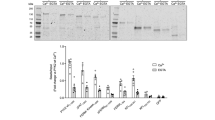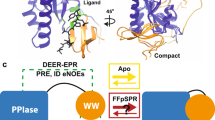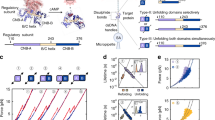Abstract
Activation of many multidomain signaling proteins requires rearrangement of autoinhibitory interdomain interactions that occlude activator binding sites. In one model for activation, the major inactive conformation exists in equilibrium with activated-like conformations that can be stabilized by ligand binding or post-translational modifications. We established the molecular basis for this model for the archetypal signaling adaptor protein Crk-II by measuring the thermodynamics and kinetics of the equilibrium between autoinhibited and activated-like states. We used fluorescence and NMR spectroscopies together with segmental isotopic labeling by means of expressed protein ligation. The results demonstrate that intramolecular domain-domain interactions both stabilize the autoinhibited state and induce the activated-like conformation. A combination of favorable interdomain interactions and unfavorable intradomain structural changes fine-tunes the population of the activated-like conformation and allows facile response to activators. This mechanism suggests a general strategy for optimization of autoinhibitory interactions of multidomain proteins.
This is a preview of subscription content, access via your institution
Access options
Subscribe to this journal
Receive 12 print issues and online access
$189.00 per year
only $15.75 per issue
Buy this article
- Purchase on Springer Link
- Instant access to full article PDF
Prices may be subject to local taxes which are calculated during checkout




Similar content being viewed by others
References
Schlessinger, J. Autoinhibition control. Science 300, 750–752 (2003).
Ferguson, K.M. et al. EGF activates its receptor by removing interactions that autoinhibit ectodomain dimerization. Mol. Cell 11, 507–517 (2003).
Smock, R.G. & Gierasch, L.M. Sending signals dynamically. Science 324, 198–203 (2009).
Chen, L. et al. Structural insight into the autoinhibition mechanism of AMP-activated protein kinase. Nature 459, 1146–1149 (2009).
Pawson, T. & Nash, P. Assembly of cell regulatory systems through protein interaction domains. Science 300, 445–452 (2003).
Yao, X., Rosen, M.K. & Gardner, K.H. Estimation of the available free energy in a LOV2-Jα photoswitch. Nat. Chem. Biol. 4, 491–497 (2008).
Li, P., Martins, I.R., Amarasinghe, G.K. & Rosen, M.K. Internal dynamics control activation and activity of the autoinhibited Vav DH domain. Nat. Struct. Mol. Biol. 15, 613–618 (2008).
Miloushev, V.Z. et al. Dynamic properties of a type II cadherin adhesive domain: implications for the mechanism of strand-swapping of classical cadherins. Structure 16, 1195–1205 (2008).
Muralidharan, V. et al. Domain-specific incorporation of noninvasive optical probes into recombinant proteins. J. Am. Chem. Soc. 126, 14004–14012 (2004).
Tang, L., Roulhac, P.L. & Fitzgerald, M.C. H/D exchange and mass spectrometry-based method for biophysical analysis of multidomain proteins at the domain level. Anal. Chem. 79, 8728–8739 (2007).
Feller, S.M. Crk family adaptors—signalling complex formation and biological roles. Oncogene 20, 6348–6371 (2001).
Nojima, Y. et al. Integrin-mediated cell adhesion promotes tyrosine phosphorylation of p130Cas, a Src homology 3–containing molecule having multiple Src homology 2-binding motifs. J. Biol. Chem. 270, 15398–15402 (1995).
Schaller, M.D. & Parsons, J.T. pp125FAK-dependent tyrosine phosphorylation of paxillin creates a high-affinity binding site for Crk. Mol. Cell. Biol. 15, 2635–2645 (1995).
Schaller, M.D. & Parsons, J.T. Focal adhesion kinase and associated proteins. Curr. Opin. Cell Biol. 6, 705–710 (1994).
Knudsen, B.S., Feller, S.M. & Hanafusa, H. Four proline-rich sequences of the guanine-nucleotide exchange factor C3G bind with unique specificity to the first Src homology 3 domain of Crk. J. Biol. Chem. 269, 32781–32787 (1994).
Ren, R., Ye, Z.S. & Baltimore, D. Abl protein-tyrosin kinase selects the Crk adapter as a substrate using SH3-binding sites. Genes Dev. 8, 783–795 (1994).
Hasegawa, H. et al. DOCK180, a major CRK-binding protein, alters cell morphology upon translocation to the cell membrane. Mol. Cell. Biol. 16, 1770–1776 (1996).
Kiyokawa, E. et al. Activation of Rac1 by a Crk SH3-binding protein, DOCK180. Genes Dev. 12, 3331–3336 (1998).
Kobashigawa, Y. et al. Structural basis for the transforming activity of human cancer-related signaling adaptor protein CRK. Nat. Struct. Mol. Biol. 14, 503–510 (2007).
Feller, S.M., Knudsen, B. & Hanafusa, H. c-Abl kinase regulates the protein binding activity of c-Crk. EMBO J. 13, 2341–2351 (1994).
Sarkar, P., Reichman, C., Saleh, T., Birge, R.B. & Kalodimos, C.G. Proline cis-trans isomerization controls autoinhibition of a signaling protein. Mol. Cell 25, 413–426 (2007).
Cowburn, D. Moving parts: how the adaptor protein CRK is regulated, and regulates. Nat. Struct. Mol. Biol. 14, 465–466 (2007).
Mochizuki, N. et al. Crk activation of JNK via C3G and R-Ras. J. Biol. Chem. 275, 12667–12671 (2000).
Wu, X. et al. Structural basis for the specific interaction of lysine-containing proline-rich peptides with the N-terminal SH3 domain of c-Crk. Structure 3, 215–226 (1995).
Demers, J.-P. & Mittermaier, A. Binding mechanism of an SH3 domain studied by NMR and ITC. J. Am. Chem. Soc. 131, 4355–4367 (2009).
Wildes, D. & Marqusee, S. Hydrogen exchange and ligand binding: ligand-dependent and ligand-independent protection in the Src SH3 domain. Protein Sci. 14, 81–88 (2005).
Wang, C., Pawley, N.H. & Nicholson, L.K. The role of backbone motions in ligand binding to the c-Src SH3 domain. J. Mol. Biol. 313, 873–887 (2001).
Cowburn, D. & Muir, T.W. Segmental isotopic labeling using expressed protein ligation. Methods Enzymol. 339, 41–54 (2001).
Zvara, A. et al. Activation of the focal adhesion kinase signaling pathway by structural alterations in the carboxyl-terminal region of c-CrkII. Oncogene 20, 951–961 (2001).
Lakowicz, J.R. Principles of Fluorescence Spectroscopy (Springer, New York, 2006).
Eftink, M.R. & Ghiron, C.A. Exposure of tryptophanyl residues in proteins. Quantitative determination by fluorescence quenching studies. Biochemistry 15, 672–680 (1976).
Muralidharan, V. et al. Solution structure and folding characteristics of the C-terminal SH3 domain of c-Crk-II. Biochemistry 45, 8874–8884 (2006).
Di Nardo, A.A., Larson, S.M. & Davidson, A.R. The relationship between conservation, thermodynamic stability, and function in the SH3 domain hydrophobic core. J. Mol. Biol. 333, 641–655 (2003).
Zhou, H.X. Quantitative relation between intermolecular and intramolecular binding of pro-rich peptides to SH3 domains. Biophys. J. 91, 3170–3181 (2006).
Donaldson, L.W., Gish, G., Pawson, T., Kay, L.E. & Forman-Kay, J.D. Structure of a regulatory complex involving the Abl SH3 domain, the Crk SH2 domain, and a Crk-derived phosphopeptide. Proc. Natl. Acad. Sci. USA 99, 14053–14058 (2002).
Porter, M., Schindler, T., Kuriyan, J. & Miller, W.T. Reciprocal regulation of Hck activity by phosphorylation of Tyr527 and Tyr416. J. Biol. Chem. 275, 2721–2726 (2000).
Sarkar, P., Reichman, C., Saleh, T., Birge, R.B. & Kalodimos, C.G. Proline cis-trans isomerization controls autoinhibtion of a signaling protein. Mol. Cell 25, 413–426 (2007).
Swain, J.F. et al. Hsp70 chaperone ligands control domain association via an allosteric mechanism mediated by the interdomain linker. Mol. Cell 26, 27–39 (2007).
Blaschke, U.K., Cotton, G.J. & Muir, T.W. Synthesis of multi-domain proteins using expressed protein ligation: strategies for segmental isotopic labeling of internal regions. Tetrahedron 56, 9461–9470 (2000).
Acknowledgements
This work was supported by US National Institutes of Health (NIH) grants GM070941 (D.P.R.), EB001991 (T.W.M.), GM55843 (T.W.M.) and GM59273 (A.G.P.). D.P.R., T.W.M. and A.G.P. are members of the New York Structural Biology Center (NYSBC) and are supported by NIH grant GM66354. We thank K. Dutta and S. Bhattacharya for their help in collecting NMR data at the NYSBC.
Author information
Authors and Affiliations
Contributions
J.-H.C. designed and conducted all experiments, analyzed the data and helped write the paper. V.M. and M.V.-P. helped to synthesize the ligands and prepare the segmentally labeled protein. D.P.R., T.W.M. and A.G.P. designed the experiments, analyzed the data and helped write the paper.
Corresponding authors
Ethics declarations
Competing interests
The authors declare no competing financial interests.
Supplementary information
Supplementary Text and Figures
Supplementary Figures 1–7 and Supplementary Methods (PDF 985 kb)
Rights and permissions
About this article
Cite this article
Cho, JH., Muralidharan, V., Vila-Perello, M. et al. Tuning protein autoinhibition by domain destabilization. Nat Struct Mol Biol 18, 550–555 (2011). https://doi.org/10.1038/nsmb.2039
Received:
Accepted:
Published:
Issue Date:
DOI: https://doi.org/10.1038/nsmb.2039
This article is cited by
-
Domain organization differences explain Bcr-Abl's preference for CrkL over CrkII
Nature Chemical Biology (2012)



